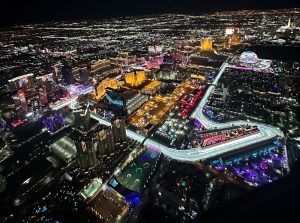
View from above// Watching the race from a helicopter, spectators are able to see the whole track, showcasing the heart of the city. The 50-lap, 3.853 mile track runs down Las Vegas Boulevard, passing iconic casinos such as Planet Hollywood, Harrah’s, and Paris Las Vegas. (Photo courtesy of Tom Cognian)
Formula One: the spectacle that pit stopped in Las Vegas
by Madeline Vernaci
Car racing has been prevalent in the United States for over a century, and motorsport as a whole has seen many different types of races and championships. For years, the IndyCar Series and NASCAR have competed to be the most popular motorsport in the United States, but they’re no longer the only top competitors as Formula One rises in the ranks to meet them. Now, as Formula One rises in popularity, new races have been added to the calendar, including the Las Vegas Grand Prix.
Although it is just now becoming a growing spectacle in the United States, Formula One has been around for decades. It is an international motorsport championship that officially began in 1950, declaring a World Champion every year since its inception. Record holders in the sport include the retired seven-time world champion Michael Schumacher, as well as the seven-time world champion Lewis Hamilton, who currently drives for Mercedes. New players arrive each year as teams discover aspiring drivers, most often from the lower-division championship, Formula 2. Max Verstappen, a current driver for Red Bull Racing and winner of the last three Formula One championships who saw his debut in 2015, threatens to overthrow long-standing champions as his number of wins grows nearly every race.
This race was no different, as Verstappen claimed another win during the inaugural race of the Las Vegas Grand Prix track. Despite the fact that he started from behind Ferrari driver Charles Leclerc, who held pole (or first) position, Verstappen fought a hard-won race against Leclerc and other top contenders to win that spot. Although he gave a dedicated effort in the race, he was not the only driver on the grid to face challenges to finish where he did. Verstappen’s Red Bull teammate, Sergio Perez, also had a remarkable race, starting in 11th place and slowly but steadily making his way to 2nd.
Unfortunately, the road to being able to host the new Las Vegas Grand Prix has not been an easy one. The track itself has faced increasing controversy, as construction interfered with residents’ daily lives and has even torn apart parts of the iconic Las Vegas Strip. With how quickly the construction of the track was done, its safety and conditions for drivers have also been contested. Even some of the drivers voiced concerns about the track since they were unsure about what conditions they could expect during the race.
Following the conclusion of the race, the Las Vegas Grand Prix and Formula One’s parent company Liberty Media may be facing class action lawsuits. During practice on Thursday, Ferrari driver Carlos Sainz Jr. ran over a water valve cover, reportedly causing millions in damage to his car, and resulting in spectators in the stands being asked to leave. Even though tickets were sold reaching prices in the thousands, the only refunds those fans received was a $200 voucher for merchandise.
From oil spills on the starting grid causing difficulties for drivers to low tire temperatures under a safety car where speeds are greatly reduced, there were many different concerns raised by drivers following the conclusion of the Las Vegas GP. The governing body of F1, the Fédération Internationale de l’Automobile (more commonly known as the FIA) addresses all concerns brought to light and determines how they will be dealt with.
While the spectacle surrounding the track this year is astounding, this race is not the first time that the sport has been in Las Vegas. In 1981 and 1982, the Caesar’s Palace Grand Prix was included in the Formula One World Championship, albeit with a much smaller track than the current Las Vegas GP. While it did not appear in any following F1 race calendar, the track at Caesar’s Palace was used for two more years in 1983 and 1984 as an IndyCar track.
The first Grand Prix to be held in the United States under the name of the United States Grand Prix was in Sebring, Florida, in 1959. Since then, the United States Grand Prix has been held 52 times at ten different locations, and currently resides at the Circuit of the Americas in Austin, Texas. The arrival of the Las Vegas Grand Prix makes it the third race on the Formula One calendar to take place in the United States, the other being the Miami Grand Prix, which was first held in 2022.
Despite the trials and tribulations that occurred throughout the process of the spectacle that was the 2023 Las Vegas Grand Prix, the track has already been confirmed to be on the schedule for the 2024 FIA Formula One World Championship. Fans of the sport, especially those in the United States, look forward to seeing the competition play out next year.











